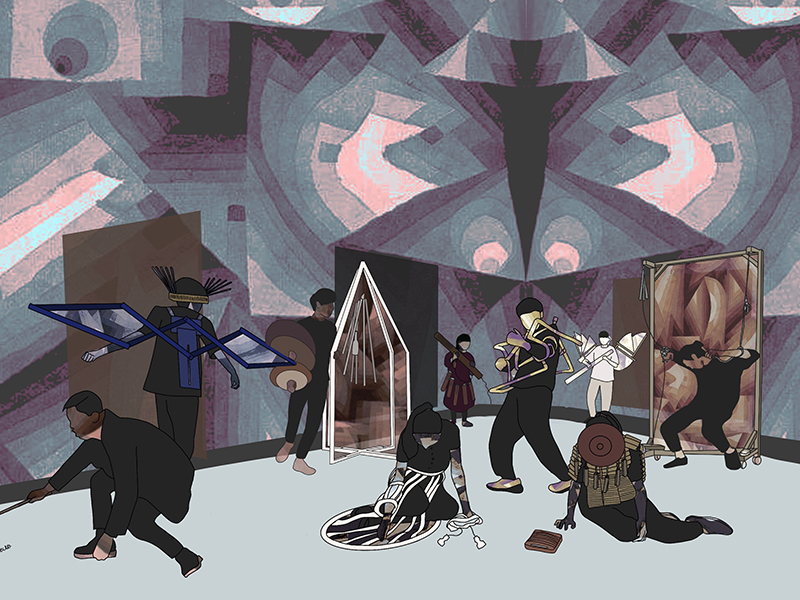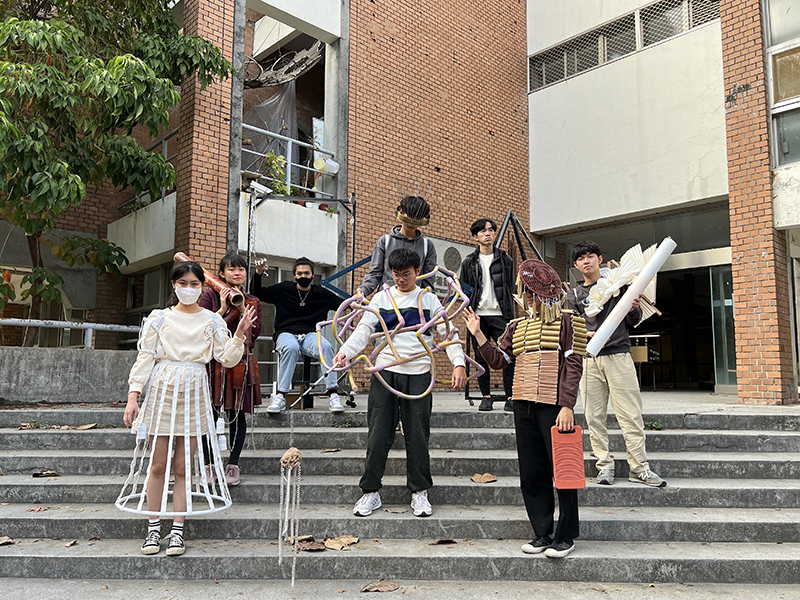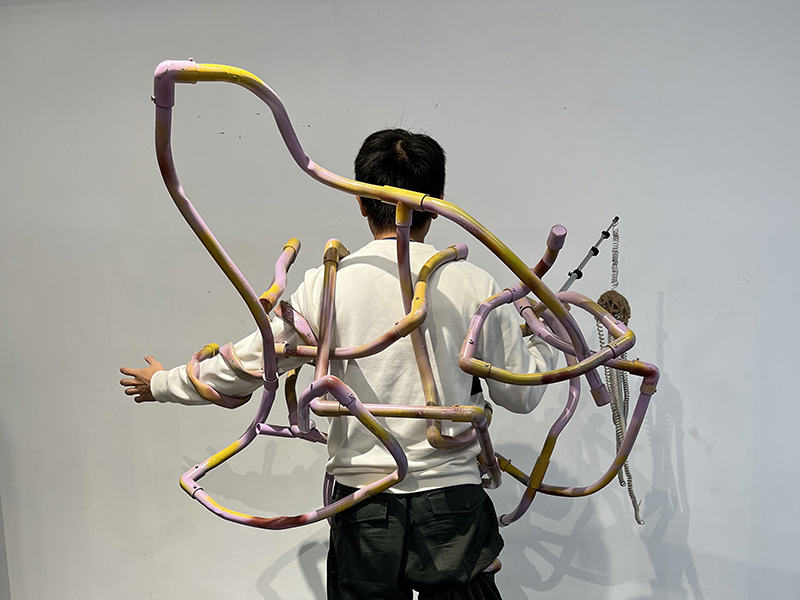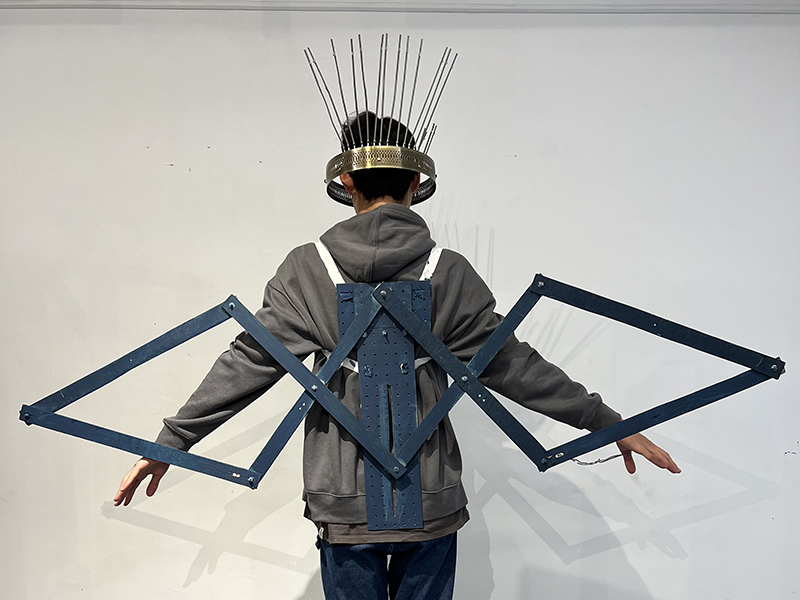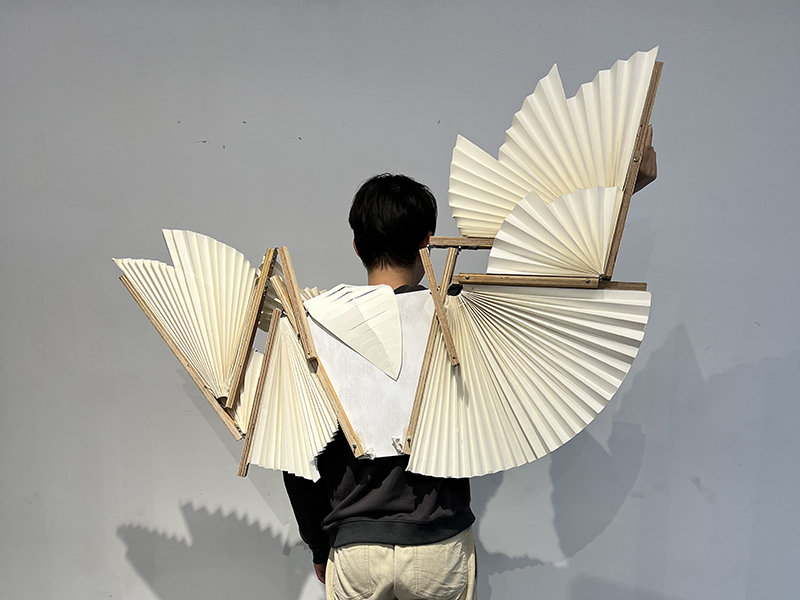指導老師:張庭嘉
Advisor: Ting-jia Zhang
成員:陳逸嘉、王紹倫、朱彥儒、林姿㚬、梁庭嘉、張誠浩、詹凱博、林佳臻
Members: Yi-chia Chen, Shao-lun Wang, Yen-ju Chu, Tzu-chun Lin, Ting-chia Liang, Cheng-hao Zhang, Kai-bo Chan, Chia-chen Lin
保羅.克利的夢境
Paul Klee’s Dream
站在空間的基礎上,我們可以從兩個向度來理解夢境。其一,我們可以將夢境視為現實世界中各式物件的重新組合,當我們進入睡眠,我們感知到這些現實中的物件如同碎片般重新組裝成另外一種真實。其二,我們可以將現實世界視為自由的夢境世界中的其中一種穩定狀態,也是人類經歷較久的時空,我們來自自由的夢境世界,自由的夢境世界才是我們存在的本質。而超越夢境本質的探究本身,作為空間的設計者、夢境的設計者、現實世界的設計者,皆須掌握各個狀態應具備的不變元素—記憶、時間、物質、環境、自我。學生嘗試在保羅.克利的畫作《水晶漸層》獲得靈感,創造一齣探索夢境的舞台劇,夢境中呈現進入夢境的主角,心境中的好奇、混沌、束縛、秩序、失序,以及不斷墜入夢境的過程,此時,分鏡的設計與對人體尺寸的基礎了解顯得相當重要,這些基礎協助設計者透過分鏡圖,釐清自身於特定時間,對場景的效果與安排。
Standing on the basic concepts of spatial design, we can understand dreams from two dimensions. Firstly, we can perceive dreams as a recombination of various objects from the real world. When we enter sleep, we perceive these real-world objects as fragmented pieces rearranged into another kind of reality. Secondly, we can view the real world as one stable state within the free dream world, which is a longer-lasting time and space experienced by humans. We come from the free dream world, and it is in the free dream world that our essence exists.
Exploring beyond the essence of dreams itself, as designers of space, dreamscapes, and the real world, we must grasp the invariant elements that each state should possess: memory, time, material, environment, and self. Inspired by Paul Klee's painting "Crystal Gradation," students attempt to create a stage play that explores dreams, depicting the protagonist entering the dream with curiosity, chaos, constraints, order, and disorder within their state of mind. The process of constantly plunging into the dream is portrayed. At this point, the design of storyboards and a basic understanding of human dimensions become crucial. These foundations assist designers in clarifying the effects and arrangements of scenes at specific times through storyboard sketches.
Advisor: Ting-jia Zhang
成員:陳逸嘉、王紹倫、朱彥儒、林姿㚬、梁庭嘉、張誠浩、詹凱博、林佳臻
Members: Yi-chia Chen, Shao-lun Wang, Yen-ju Chu, Tzu-chun Lin, Ting-chia Liang, Cheng-hao Zhang, Kai-bo Chan, Chia-chen Lin
保羅.克利的夢境
Paul Klee’s Dream
站在空間的基礎上,我們可以從兩個向度來理解夢境。其一,我們可以將夢境視為現實世界中各式物件的重新組合,當我們進入睡眠,我們感知到這些現實中的物件如同碎片般重新組裝成另外一種真實。其二,我們可以將現實世界視為自由的夢境世界中的其中一種穩定狀態,也是人類經歷較久的時空,我們來自自由的夢境世界,自由的夢境世界才是我們存在的本質。而超越夢境本質的探究本身,作為空間的設計者、夢境的設計者、現實世界的設計者,皆須掌握各個狀態應具備的不變元素—記憶、時間、物質、環境、自我。學生嘗試在保羅.克利的畫作《水晶漸層》獲得靈感,創造一齣探索夢境的舞台劇,夢境中呈現進入夢境的主角,心境中的好奇、混沌、束縛、秩序、失序,以及不斷墜入夢境的過程,此時,分鏡的設計與對人體尺寸的基礎了解顯得相當重要,這些基礎協助設計者透過分鏡圖,釐清自身於特定時間,對場景的效果與安排。
Standing on the basic concepts of spatial design, we can understand dreams from two dimensions. Firstly, we can perceive dreams as a recombination of various objects from the real world. When we enter sleep, we perceive these real-world objects as fragmented pieces rearranged into another kind of reality. Secondly, we can view the real world as one stable state within the free dream world, which is a longer-lasting time and space experienced by humans. We come from the free dream world, and it is in the free dream world that our essence exists.
Exploring beyond the essence of dreams itself, as designers of space, dreamscapes, and the real world, we must grasp the invariant elements that each state should possess: memory, time, material, environment, and self. Inspired by Paul Klee's painting "Crystal Gradation," students attempt to create a stage play that explores dreams, depicting the protagonist entering the dream with curiosity, chaos, constraints, order, and disorder within their state of mind. The process of constantly plunging into the dream is portrayed. At this point, the design of storyboards and a basic understanding of human dimensions become crucial. These foundations assist designers in clarifying the effects and arrangements of scenes at specific times through storyboard sketches.
